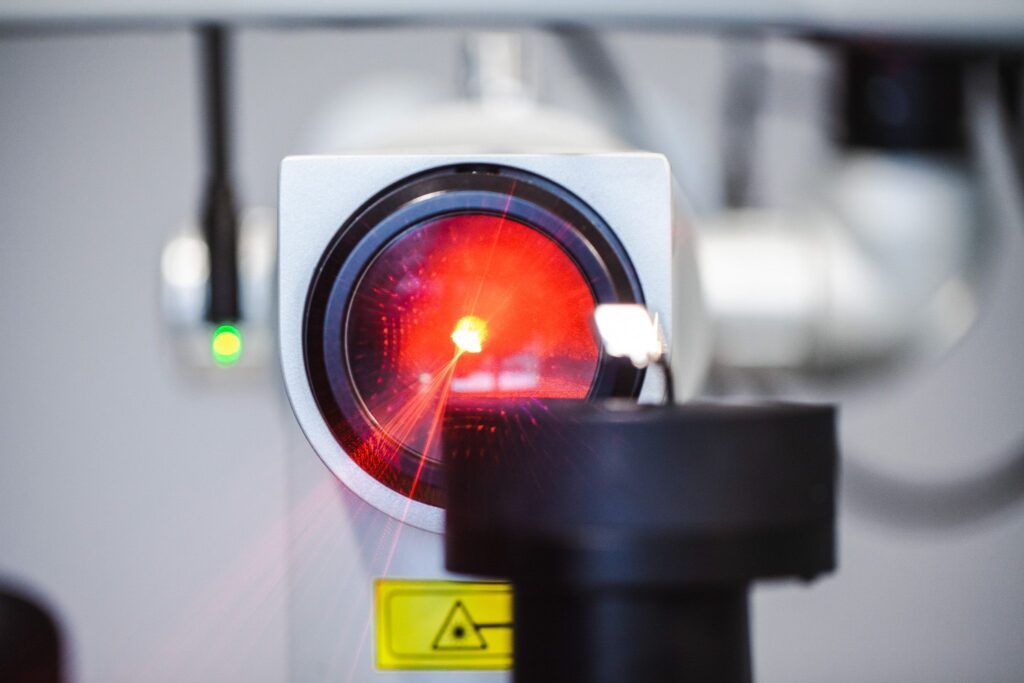The term glaucoma is used to describe various eye diseases that cause damage to the optic nerve and retina. Glaucoma is the second leading cause of blindness worldwide.
There are many causes of glaucoma. However, intraocular pressure plays a key role. In most glaucomas, intraocular pressure is elevated above a defined normal value. If intraocular pressure elevation persists for a long time, it can cause permanent visual field defects. As a sufferer, this impairment only becomes noticeable when the optic nerve is already very severely damaged. However, the existing damage can then no longer be reversed. Since glaucoma does not show any symptoms beforehand, regular monitoring of eye pressure is important from the age of 40.

Glaucoma can be treated in several ways, depending on its severity and form. We explain how:
Special forms of so-called secondary glaucoma can be treated with laser coagulation. Secondary glaucoma is always a consequence of another disease such as severe diabetic changes of the retina or secondary changes after retinal vascular occlusion. Laser coagulation involves directing focused laser beams at the damaged areas of the retina. This results in thermal destruction of the absorbing tissue, which can be precisely dosed by pulsed laser beams. In this way, laser coagulation treats the retina, preventing further blood vessels from proliferating. Before the procedure, you will be given painkilling and anesthetic eye drops.
If you have narrow-angle glaucoma, it can be treated with a procedure called laser iridotomy. Tiny holes are created in the iris with a laser. These serve as an additional flow opening for aqueous humor circulation between the anterior and posterior chambers of the eye. The anterior chamber deepens as a result of the treatment, and intraocular pressure is lowered due to improved aqueous humor outflow. Thus, the risk of a glaucoma attack is minimized.
The ray body produces the aqueous humor of the eyes. Sclerotherapy uses focused cold or heat to destroy part of the radiolucent body, which reduces the production of ocular fluid. Less fluid in the eye also results in less pressure on the optic nerves and retina. Ideally, intraocular pressure remains so well regulated after surgery that no further damage results.
Valve surgery involves placing a tiny plastic tube from the front chamber of the eye through the eye socket into outer layers of the eye. This allows the aqueous humor to drain better from inside the eye. The pressure inside the eye is thus considerably reduced and very often leads to a stabilization of the findings.
SLT treatment, also known as Selective Laser Trabeculoplasty, aims to improve the drainage of the inner eye aqueous humor. This is especially important in glaucoma (cataract) because the balance between production and outflow ensures a balanced intraocular pressure. The main purpose of SLT treatment is to preserve your vision and protect the optic nerve from (further) damage.
The SLT laser activates the pigment cells of the eye with ultra-short light pulses. The aim is to stimulate these cells with the laser light and thereby activate their self-healing process. This is to restore the balanced equilibrium for aqueous humor outflow. The pressure-lowering effect that occurs after laser treatment often lasts for a long time. The surrounding tissue is not stressed in the process. SLT treatment can be performed on an outpatient basis with anesthetic eye drops. The procedure is virtually painless and usually takes only five to ten minutes. The laser application can be repeated several times if necessary.
After a few weeks, the eye pressure should then be significantly lower than before the treatment. If the intraocular pressure rises again later, the treatment can be repeated without hesitation. If the pressure-lowering effect of SLT alone is not sufficient, additional eye drops can be used to further lower intraocular pressure.
SLT laser therapy is one of the main treatment areas at BeyondEye. By the way, the costs are borne by the statutory health insurance companies.
SLT treatment may be suitable for you if you suffer from any of the following conditions:
– Ocular hypertension. Here, treatment prevents progression to glaucoma
– Open-angle glaucoma, pseudoexfoliation glaucoma or pigment dispersion glaucoma
– In case of intolerance to glaucoma drops
– After an ALT (Argon Laser Trabeculoplasty) treatment and afterwards again increased intraocular pressure
Surgical procedures on the eye are never without risks. In all of the above procedures, in extreme cases, infection in the eye or clouding of the lens of the eye may occur. Pre-existing visual field defects may also increase. In addition, corneal damage may occur. During treatment of glaucoma, intraocular pressure may also fluctuate. In allergic persons, circulatory shock may occur in rare cases.
Also because of this, an individual and comprehensive consultation in advance of a planned procedure is essential. This allows us to weigh personal health risks well. At BeyondEye, we place special emphasis on this – so you are in safe and professional hands with us.
Would you like to make an appointment with us for your glaucoma? Then please feel free to contact us at 0221 / 87 10 50 or make an appointment online.